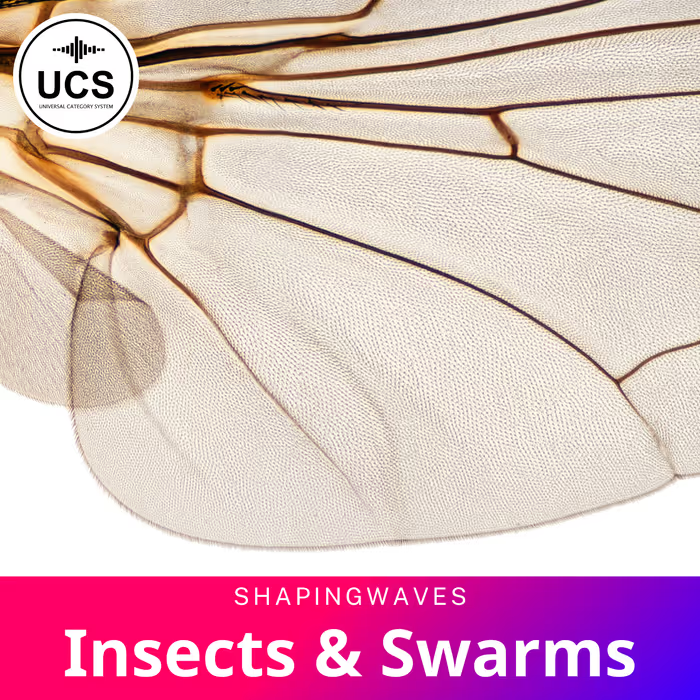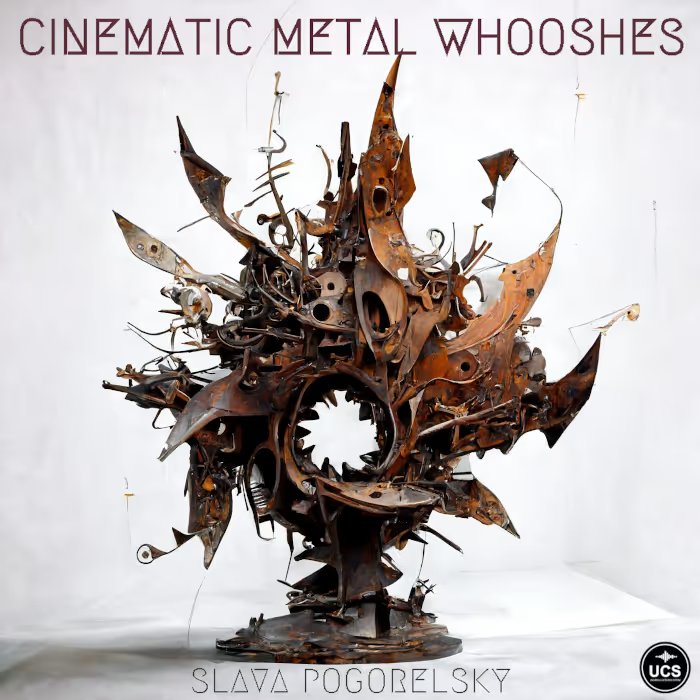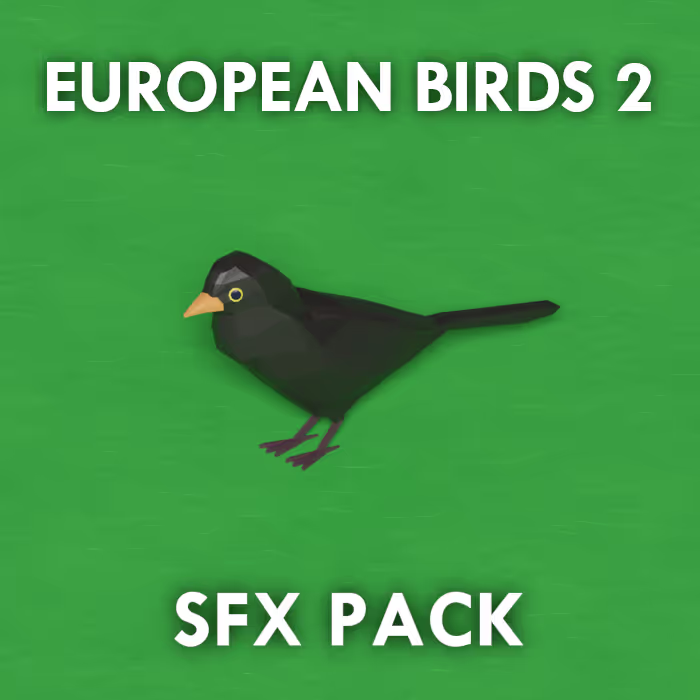I was lucky to have the opportunity to visit Alaska in June 2019. I have been inspired to travel to Alaska ever since reading One Man’s Wilderness by Richard Proenneke and The Place Where You Go to Listen by John Luther Adams. The endless light of the arctic summer is a magical place for field recording.
My Adventure Getting to Alaska
- One commercial flight from Philadelphia to Anchorage
- One bush plane flight to Lake Clark National Park
- One 5 mile boat ride across Lake Clark
- 120 miles hiking in search of recording locations
I needed to arrive in Anchorage, AK by 7:00am to catch my bush plane flight to Lake Clark National Park, so I planned my trip starting with the end in mind. I live in Philadelphia, PA so my adventure began with a 6 hour flight to Seattle, WA. I left Philly in the afternoon, spent the evening in the Seattle airport, and then caught a 1:00am flight to Anchorage, AK. Lake Clark National Park is 200 miles from any road and only accessible by bush plane. I had dreams of becoming a pilot as a kid, so I couldn’t have been more excited when I walked out of the hanger and saw the tiny four-person bush plane. The pilot cheerfully called out, “Hop in!” and I proceeded to climb in on the passenger side right next to the pilot! Our safety briefing consisted of “put your seatbelt on” and the implied understanding that if we have a crash landing, we will probably all die very quickly so there was no need to worry. Ha! After our almost nonexistent safety brief, we quickly taxied out onto the runway and took off. I was ready for my first bush plane flight!
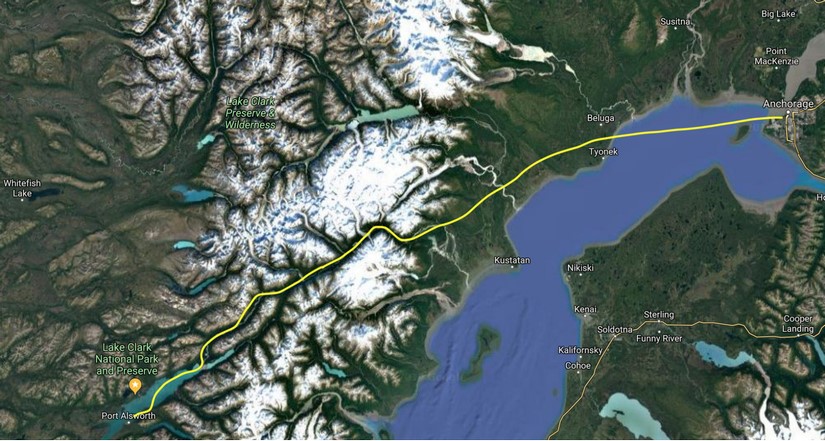 Bush Plane Flight Path
Bush Plane Flight PathWe flew from Anchorage through a mountain pass in the Alaska Range towards the southwest. As the mountains towered above and around us, I gazed with wonder at the mountain valleys filled by massive sheets of moving ice. We were flying so close to the glaciers, I felt like I could almost reach out and touch them!
While the glaciers were very impressive to my untrained eyes, the pilot informed me that, unfortunately, many of the glaciers have shrunk dramatically during his career as a pilot. That said, I’m very thankful for the chance to have seen the glaciers before they disappear even more.
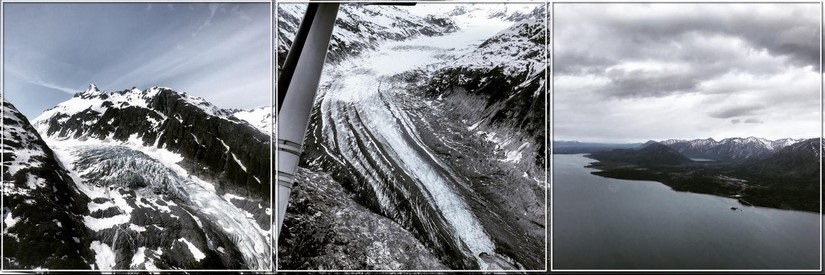
After an hour and a half, our plane touched down on a dirt runway in Lake Clark National Park. Even though I was 24 hours into my journey at that point, I had a lot of adrenaline from the flight and was ready for the final leg of the trip: a 5 mile boat ride. Lake Clark is about 40 miles long and 5 miles wide. From the middle of the lake, I was surrounded by breathtaking mountains on all sides.
Part of what drew me to Lake Clark National Park was that it has very little infrastructure compared to national parks across the continental United States. Needless to say, I was thrilled to be off the grid for 14 whole days of recording adventures!
This trip culminated in 6 sound libraries:
- Alaska: Curious Bears
- Alaska: Rain
- Alaska: Wind
- Alaska: Quiet Nature
- Alaska: Active Nature
- Alaska: Lake Waves
Location Scouting and Gear Setup:
Whenever possible, I prefer to scout locations before recording. This ensures I have a chance to deeply listen to a place without the distraction of my recording gear. Therefore, after I had set up my recording equipment each day, I hiked 5-10 miles each afternoon in search of new locations.
When recording in a dense forest, it is not always intuitive which areas sound the best, so a lot of experimentation is needed. For example, if I find a location that has potential, I start by making short, loud yells to create echoes. I then listen to how the sound naturally moves through the terrain. My goal is to find resonant spaces.
When I find a lovely spot. I sit and listen. I enjoy the space. I meditate.
Before leaving, I mark the location with a GPS waypoint on my Garmin inReach mini and then continue exploring. This way, I know exactly where to return the next day with my microphones.
When I return with my microphones, I will listen to the direction the echoes travel. For instance, if I hear that my echoes resonate and clearly move to the southwest, I’ll orient my mics towards the southwest in order to capture the best acoustic perspective of the space.
Alaska: Curious Bears
During my Alaskan adventure, I typically left my Cinela blimp unattended in Lake Clark National Park for 12-18 hours a day over the course of my 14 day trip. On one of my hikes, I discovered a well-defined game trail and decided to place my microphones near it with the hopes of capturing sounds of passing wildlife.
When I returned several hours later to check on my equipment, I discovered my microphone blimp and tripod on the ground. Upon closer inspection, I noticed the grass was trampled all around the microphones. When I checked the recording, I was thrilled to find that a curious bear had seriously investigated my microphone blimp for 20 minutes before accidentally tipping over the tripod, scaring itself, and running off. Luckily, I got great recordings and my microphones and recorder were not damaged! There was definitely some bear slobber on the blimp though!
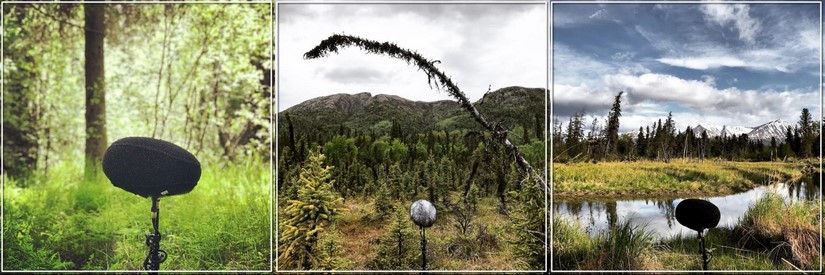
Alaska: Rain
- Listen to the full story of my arctic rain recording adventures on Tonebenders – 121 – Recording Rain with George Vlad and Thomas Rex Beverly. If you don’t have time for the full podcast, here are a few of my rain recording tips:
How to Record Rain:
- Use microphones known to perform well in high humidity. I use Sennheiser microphones. View my full gear list – here.
- Use cables made with Neutrik X-HD Series waterproof connectors. This keeps water from getting into your cable connection points.
- Use a dry bag for your recorder. I like the Sea to Summit 65L bags because they have a wide mouth and can easily fit a recording bag through the opening.
- Put your dry bag at least 25 feet away and cover it with local foliage. Otherwise you’ll just record the sound of rain hitting a dry bag.
- Use a Cinela Pianissimo Double Mid/Side blimp with a Kelly Rain Cover.
- Coat the inner cover of the Cinela Pianissimo with NixWax as Cinela directs on their website. This is a water repellant molecule that is also acoustically transparent. The water repellant causes the water to bead up and roll off while also letting the air through. Read more about how NixWax works – here.
- The honeycomb of the Kelly Rain cover disperses drops as they hit the blimp which minimizes thumps. However, don’t use the Kelly Rain cover in areas with lots of insects because they tend to get stuck in the honeycomb, buzz for hours, and ruin recordings. The honeycomb cover also doubles as excellent protection for the blimp if a bear/moose/elk decides to chew on it.
- Find a section of forest with low and dense deciduous leaves. These leaves catch the rain so drips don’t thump on the blimp. Occasional thumps during heavy rain are okay because they are easy to edit out in post.
- Waterproofing a microphone blimp is totally game changing. I can now leave my rig out in the elements for 24 hours without fear of rain. Waterproof blimps and 32-bit float recorders have opened up a whole new world of recording for me and I couldn’t be more excited.
- Build a platform of local foliage to cover the blimp for extra protection. George Vlad has an excellent video on how to build a natural rain canopy – here.
- I learned many of these rain recording techniques from George Vlad, so make sure you check out his work at Mindful Audio.
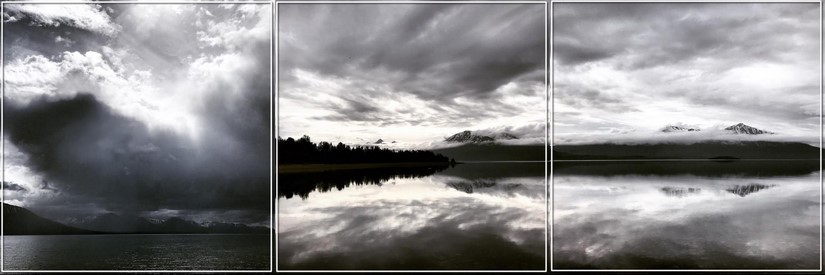
Alaska: Wind
Lake Clark is a massive 40 mile glacial lake with a major Alaska Range mountain pass at the north end of the lake. As a result of the area’s geography, wind whips down from the mountain pass and sails across the lake unimpeded. When I arrived in late May at Lake Clark National Park, the spring leaves were budding and so the boreal forest had a lovely, fresh pop of green. When the winds gusted over the lake and reached the boreal forest made up of cottonwood, birch, and spruce, the foliage came alive.
While I was in Lake Clark National Park, a strong storm came through with winds powerful enough to make 6-foot lake waves. This made for ideal wind recording conditions! It can be tricky to capture the sound of spring foliage without birdsongs, so the secret is to record during the day when there are extremely heavy winds. When winds are strong enough, birds tend to stop singing. Under these conditions, you can record daytime winds, even during springtime! Otherwise, you have to record wind at night while the majority of the wildlife sleeps or wait until winter for ideal wind recording conditions.
My favorite recording of the Alaska: Wind library was from a mixed grove of cottonwoods and spruce. The short spruce needles mix with the deciduous leaves of the cottonwoods to create a rich, full-spectrum wind complete with the eerie squeaks and creaks of the forest. I also loved mixing the sound of distant lake waves with canopy wind. When you retreat about a mile from the lakeshore, the lake waves blend beautifully with the sound of the canopy foliage. I loved finding the perfect balance between the lush canopy and a touch of distant water roaring from the waves. This balance gives the wind recordings a beautiful sense of power.
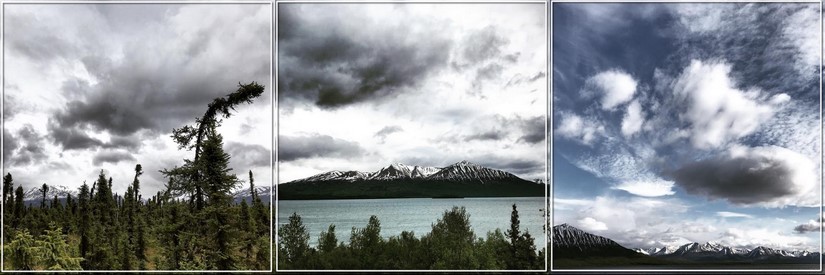
Alaska: Lake Waves
Since Lake Clark is massive, water conditions can vary from glassy to lapping to white-capped swells and sometimes these conditions can occur all on the same day! The size of the lake mixed with the rocky beach made for excellent recording conditions because mid-sized waves could form and crash without the roaring bass of an ocean beach.
If you ever want to record waves, I recommend you purchase knee or chest waders. Waders are invaluable, especially when the water temperature is just above freezing. Thanks to the waders I was wearing, I was able to stand in the water among the rocks and capture lovely swishes and gurgles as the waves broke against the shoreline.
My favorite sound from my Alaska: Lake Waves library are the waves crackling like carbonated water! The “crackling” waves is an extremely soft sound created by a gentle wave breaking among small pebbles. I was able to capture this lovely sound by holding my DPA 4060s a few inches above the water as the wave broke.
Alaska: Quiet & Active Nature
These libraries feature the best quiet and active nature moments from over 200 hours of recording in the Alaskan wilderness. For these libraries, I focused on two ecosystems: lakeshore and boreal forest.
The first half of my trip focused on the marshland around beaver ponds and Lake Clark’s shore. These recordings are full of resonant shorebirds, soothing water in the distance, and a lone moose tromping through the water right in front of my microphones!
I spent the second half of my trip in the boreal forest. I left my rig out recording continuously with the help of my waterproof Cinela Pianissimo blimp and I used an Anker USB-C battery to power my Sound Devices MixPre-6. It can run 3 channels recording at 192kHz/24-bit for about 16 hours. I typically left my mics in the woods from about 5:00pm until 11:00am the next day so that I could record long uninterrupted soundscapes. The next morning, I would hike out, change SD cards, switch the batteries, and move my microphones to a new recording location. Then, I would use the afternoon to scout new locations. As a result, I was able to record about 18 hours per day for 14 days. My microphones survived curious Grizzly Bear sniffs, moose licks, blustery winds, and several rainstorms!
Growing up in the American Southwest, I’ve grown accustomed to snakes, ticks, scorpions, and poisonous ivy. One of my favorite things about Alaska is the lack of dangerous creatures and plants! Of course, bears, moose and other large wildlife, can pose a dangerous threat, but I felt incredibly free bushwhacking without constantly watching for things that sting or bite. It is one of the best feelings in the world to wander freely through the boreal forest of Alaska.
Favorite Sounds of the Trip:
Owls are the cellos of the forest and I love catching more than one species in a recording. Hear Boreal Owls, Northern Saw-whet Owls, and Wilson’s Snipe singing their nighttime lullabies with an eerie counterpoint of voices.
https://youtu.be/qing93RqqjY
One bonus of leaving your rig out for drop and record sessions is that birds do incredibly close fly-bys!
https://youtu.be/ZhN-4_9aeE0
The Swainson’s Thrush has an incredibly rich song with a lovely rising melody. I was lucky to catch some incredibly close branch top dancing!
https://youtu.be/1ueFD89RcHs
There is nothing quite like the stately sound of a woodpecker knocking. They are the marimbas of the orchestral forest and I love when they come near my mics.
https://youtu.be/yps2-YvEwPw
Favorite Wildlife Moment:
One day while recording, I spent 30 minutes watching a Bald Eagle in a tree near the edge of Lake Clark. Patiently hoping he would make some sounds. Instead, he majestically took flight and began skimming the glassy water. He was so low to the water’s surface, the feathery tips of his giant wings skimmed the water!
He must have seen a fish because suddenly, he pulled up and prepared to dive. As he dove for his dinner, another eagle swooped in and attacked him mid-flight. Suddenly, the eagle fell out of the sky and wiped out into the ice cold lake. He was about half a mile out in the lake, flailing around. He tried multiple times to take off from the water, but was too waterlogged and heavy.
These birds are not evolved for water takeoffs and I was growing increasingly worried he was going to drown. Luckily, it turns out that Bald Eagles can swim! He started to sweep his massive wings back in forth in long breast strokes. He slowly started making progress toward the shore and although I was hopeful he might make it to the shore, he had a long way to go and the freezing water was obviously taking its toll. As he gradually slowed his pace I grew increasingly worried that he would not make it.
I ran down the shore to get a closer look and was thrilled to see him crawl onto the beach! He climbed out and shook out his soaked feathers. He looked exhausted, but happy to be alive.
Then, all of a sudden, he looked down at his talon…and he still had the salmon! He proceeded to feast on the fish and had an impromptu picnic on the beach. After warming up in the sun, he then flew off about 30 minutes later. It was such an amazing wildlife moment and I’ll remember it forever.
The trip flew by and although I was sad when the time came to leave, I knew this wouldn’t be my last time in Alaska. I’m captivated by the arctic, so stay tuned to hear about many more arctic recording adventures in the next few years. As always, thanks so much for listening.
If you want to learn more about this enchanting part of the world, I’d recommend these books:
- One Man’s Wilderness by Richard Proenneke
- The Place Where You Go to Listen by John Luther Adams
- The Farthest Place by John Luther Adams
- The Great Alone by Kristin Hannah


